Toum (The Ultimate Garlic Dip) – Quick Immersion Blender Hack
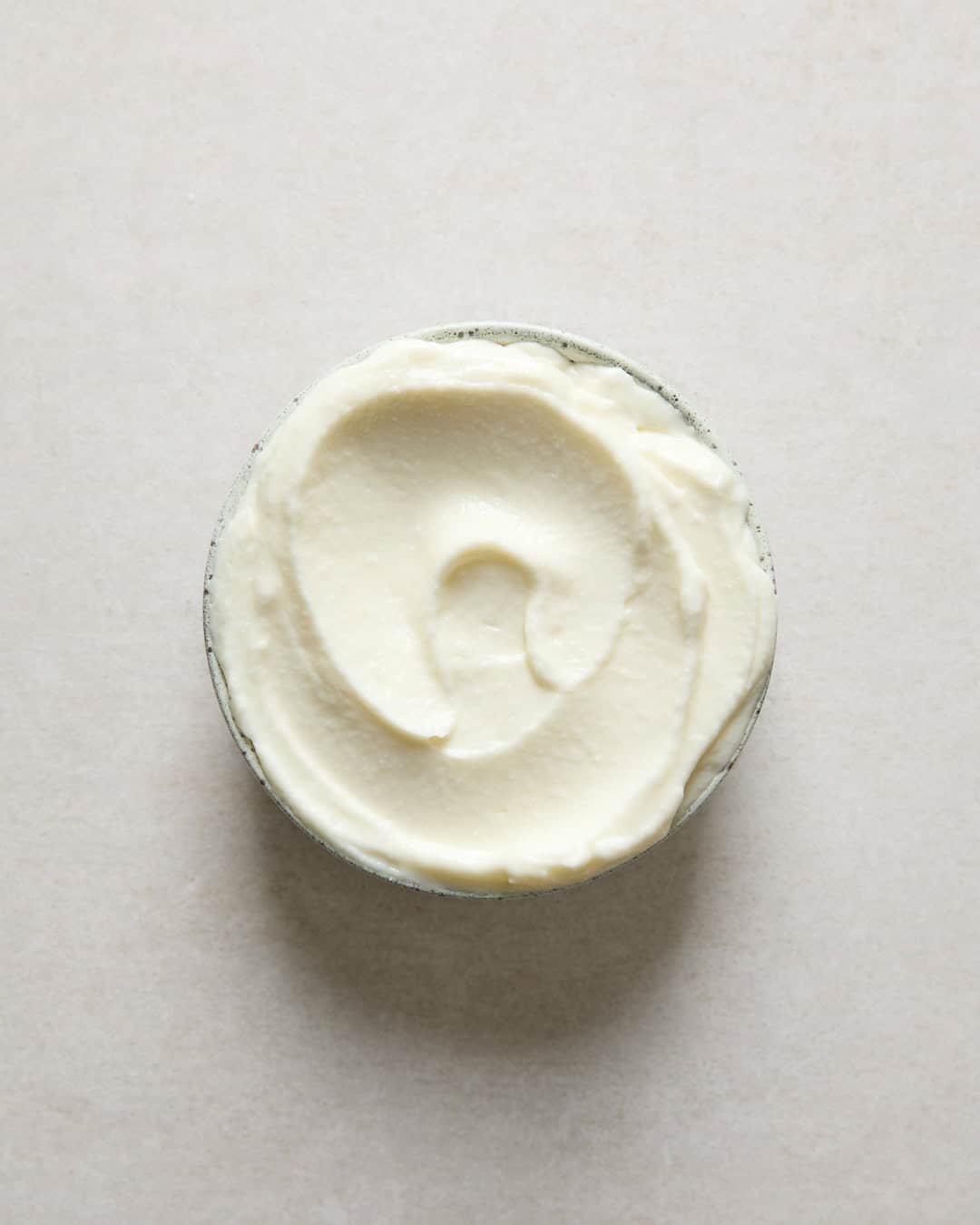
Toum is thought to have originated in Lebanon but is eaten throughout much of the Middle East. The word ‘toum’ itself translates to ‘garlic’ in Arabic, which is a testament to its key ingredient. Across the Middle East, garlic has long held a significant culinary place, not only for its flavour but also for its many health benefits including boosting the immune system and aiding digestion.
Traditionally, making Toum was a labor-intensive process, achieved by grinding garlic into a paste in a pestle and mortar and then slowly working in the oil and lemon juice. These days, a food processor is used in most kitchens. However, there is an easy hack to blend the toum in less than 60 seconds, which I am sharing in this recipe.
What is Toum?
Toum is a creamy garlic sauce from Levantine cuisine, known for its bold flavor and versatility. Made from simple ingredients like fresh garlic, lemon juice and oil, this sauce can elevate a variety of dishes. Whether you’re looking for easy Toum recipes or ways to use it in a mezze spread, this garlic sauce adds a delicious kick to your meals. You can pair it with roasted vegetables, use it on sandwiches, or enjoy it as a dip. With its smooth texture and tangy taste, homemade Toum is a must-try for anyone wanting to bring more flavor to everyday dishes.
History of Toum
Toum has deep roots in Middle Eastern culinary traditions, where garlic is a treasured ingredient. Traditionally served with grilled meats, this garlic sauce has been a staple for generations. The technique of emulsifying garlic with oil creates a rich, creamy consistency that has gained popularity beyond Lebanon, where it is often thought to have originated. Today, Toum is loved worldwide, often found in Mediterranean restaurants and home kitchens alike, making it a beloved condiment for various dishes.
Ingredients You’ll Need and Substitutions
To make your own homemade toum, gather these essential ingredients:
- Fresh garlic: The main ingredient, providing the sauce’s signature bold flavour.
- Lemon juice: Adds a bright acidity that balances the richness.
- Rapeseed, sunflower or mild olive (not extra-virgin) oil: Using extra virgin oils will give the Toum a bitter flavor, so try to opt for natural oils.
How to Make Toum (Step-by-Step)
Prepare your ingredients by gathering garlic, salt, oil, lemon juice and cold water. Peel all of the garlic. You can speed this up by soaking the cloves in boiling water for just 1 minute and draining them immediately. The peel will slide off easily.

Cut each garlic clove in half and remove the germ with a small knife. Then cut the halves in half again to have smaller chunks of garlic.

Place the garlic cloves into the jug of the immersion blender. Sprinkle in the salt. Pour in the oil, the lemon juice and the cold water. Insert the immersion blender into the jug, ensuring it’s positioned at the bottom. Turn on the hand blender and start puréeing the garlic without lifting it.

As you blend, the immersion blender will automatically suck in small amounts of oil to emulsify with the garlic.
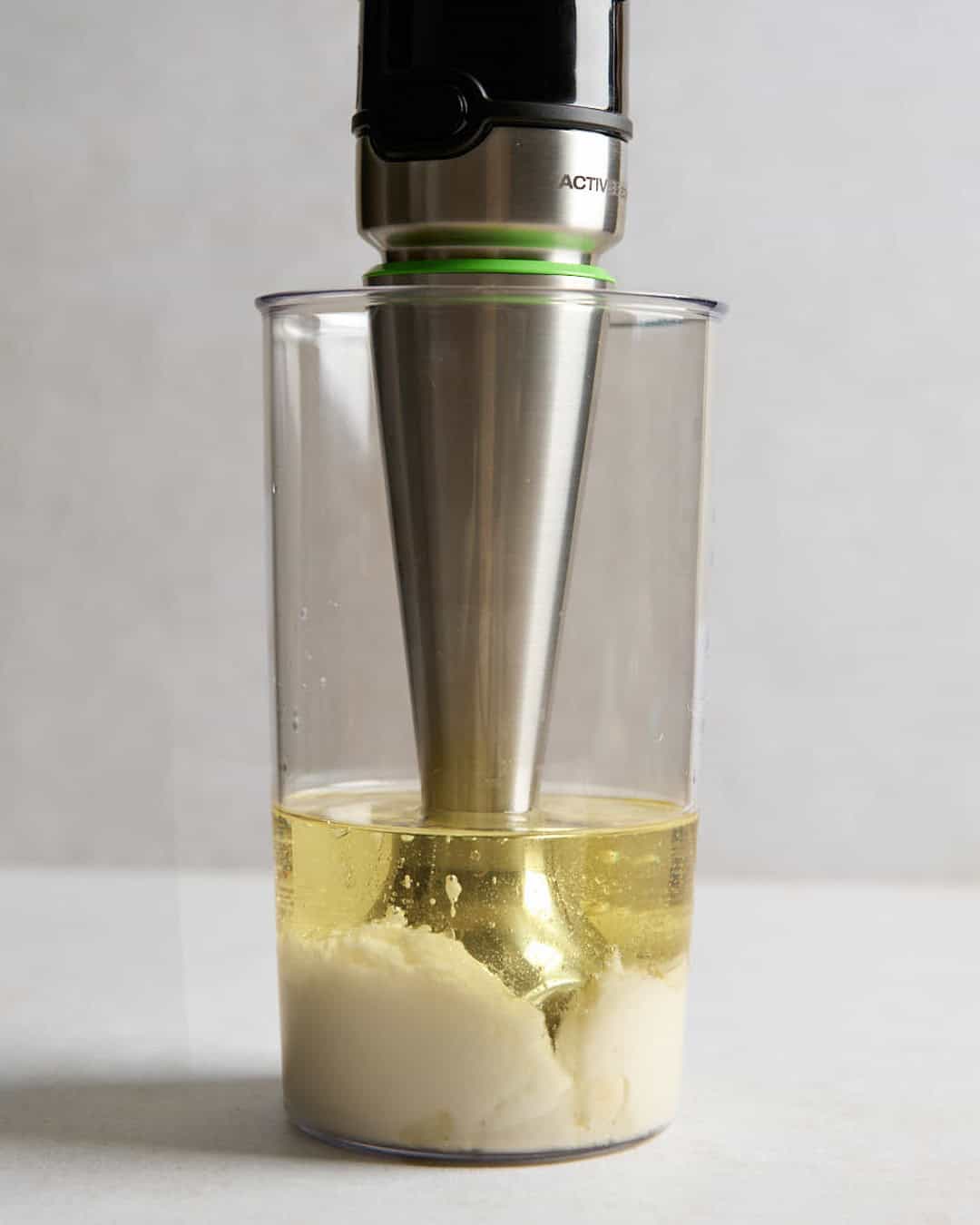
After a few seconds, begin to lift the blender slightly to allow a small amount of oil to stream in, then press it down again.
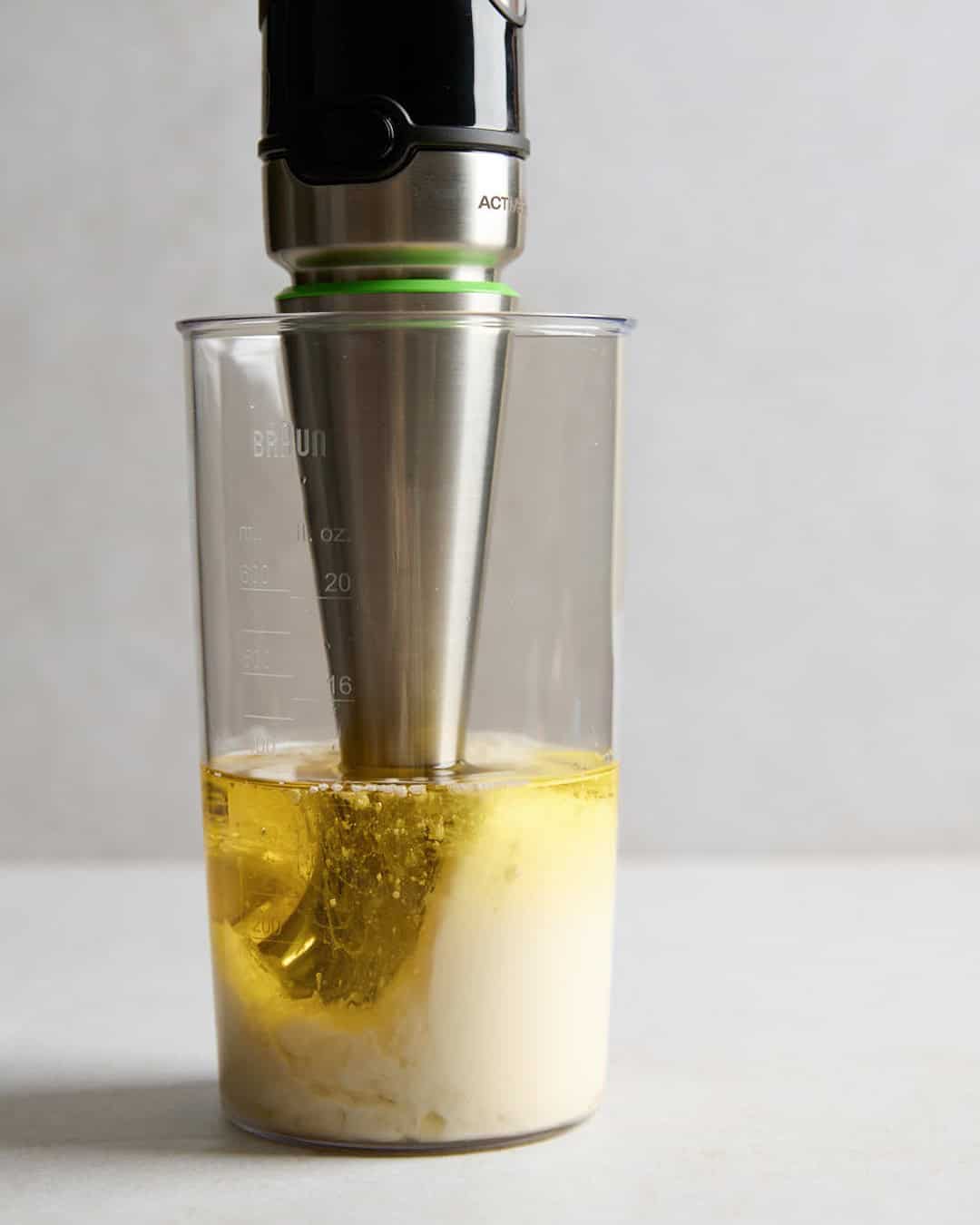
Continue this motion to incorporate the remaining oil until the emulsification is complete.
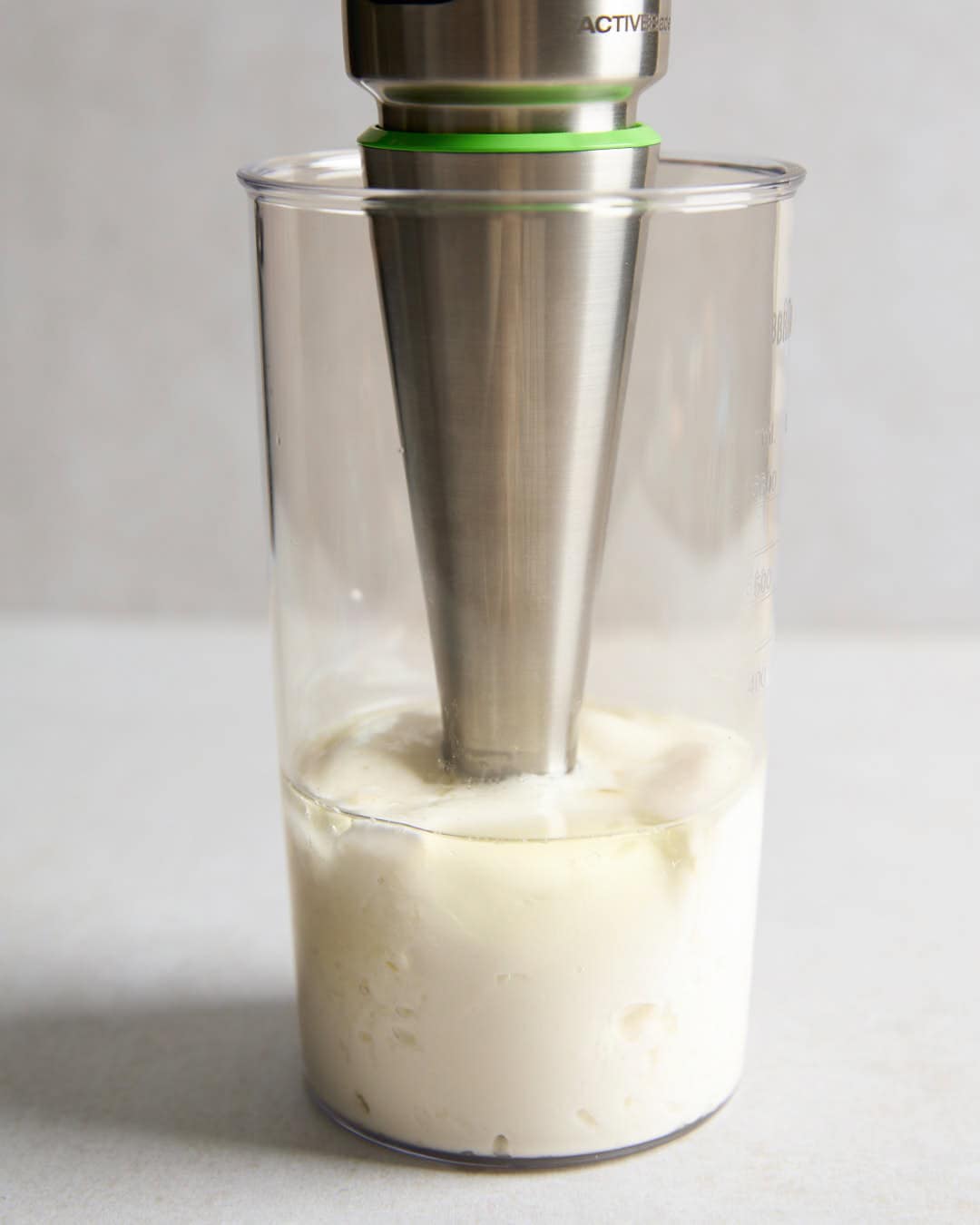
Check for any garlic pieces that haven’t been blended yet and work them in by moving the blender around.

Your Toum should have a thick consistency similar to mayonnaise. Scrape the Toum into a bowl using a spatula and serve immediately or store in the refrigerator for later use.

Useful Tips
- Fresh garlic: Always use fresh garlic for the best flavour and to help with the emulsification—avoid pre-minced varieties.
- Emulsification is crucial: Only lift the blender very gently to allow a small stream of oil to emulsify with the garlic. Taking this slowly is key for a successful emulsification.
- Toum is too thin or too thick: you can always adjust the texture by adding more oil (to make it thicker) or more cold water/lemon juice (too make it thinner)
- How to Fix a Broken Toum? The easiest way to fix a broken emulsion is to add around four to six tablespoons of aquafaba (the liquid in a tin of chickpeas). Now use the immersion blender to blend it all together. Within a few seconds, it should emulsify into a smooth sauce.
Why You’ll Love This Recipe
- Naturally & traditionally vegan
- quick & easy
- versatile to pair with other foods
- the perfect dip
How to Store Toum
To keep your homemade Toum, store it in an airtight container in the fridge for up to four weeks.
**I receive a small commission from affiliate links on this page**

Toum
Equipment
Ingredients
- 1 garlic bulb (60g - 70g cloves)
- 40 ml lemon juice
- 200 ml rapeseed (vegetable) oil or sunflower or mild olive (not extra-virgin) oil
Instructions
- Peel all of the garlic. You can speed this up by soaking the cloves in boiling water for just 1 minute and draining them immediately. The peel will slide off easily. Cut each garlic clove in half and remove the germ with a small knife. Then cut the halves in half again to have smaller chunks of garlic.
- Place the garlic into the jug of a immersion blender and add 1/2 tsp salt followed by the sunflower oil, lemon juice and 1 tbsp of cold water. With the hand blender positioned on the bottom of the jug, purée the garlic into a smooth paste without lifting the blender. It will automatically suck in small amounts of oil to emulsify with the garlic. After a couple of seconds, start lifting the blender minimally, only to allow a fraction more oil to stream in, then press it down again. Keep doing this to work in the rest of the oil until the emulsification is complete (you will notice the sound change). Then work in any of the garlic that hasn’t been blended yet. Your Toum should be as thick as mayonnaise. Scrape it into a bowl and serve.

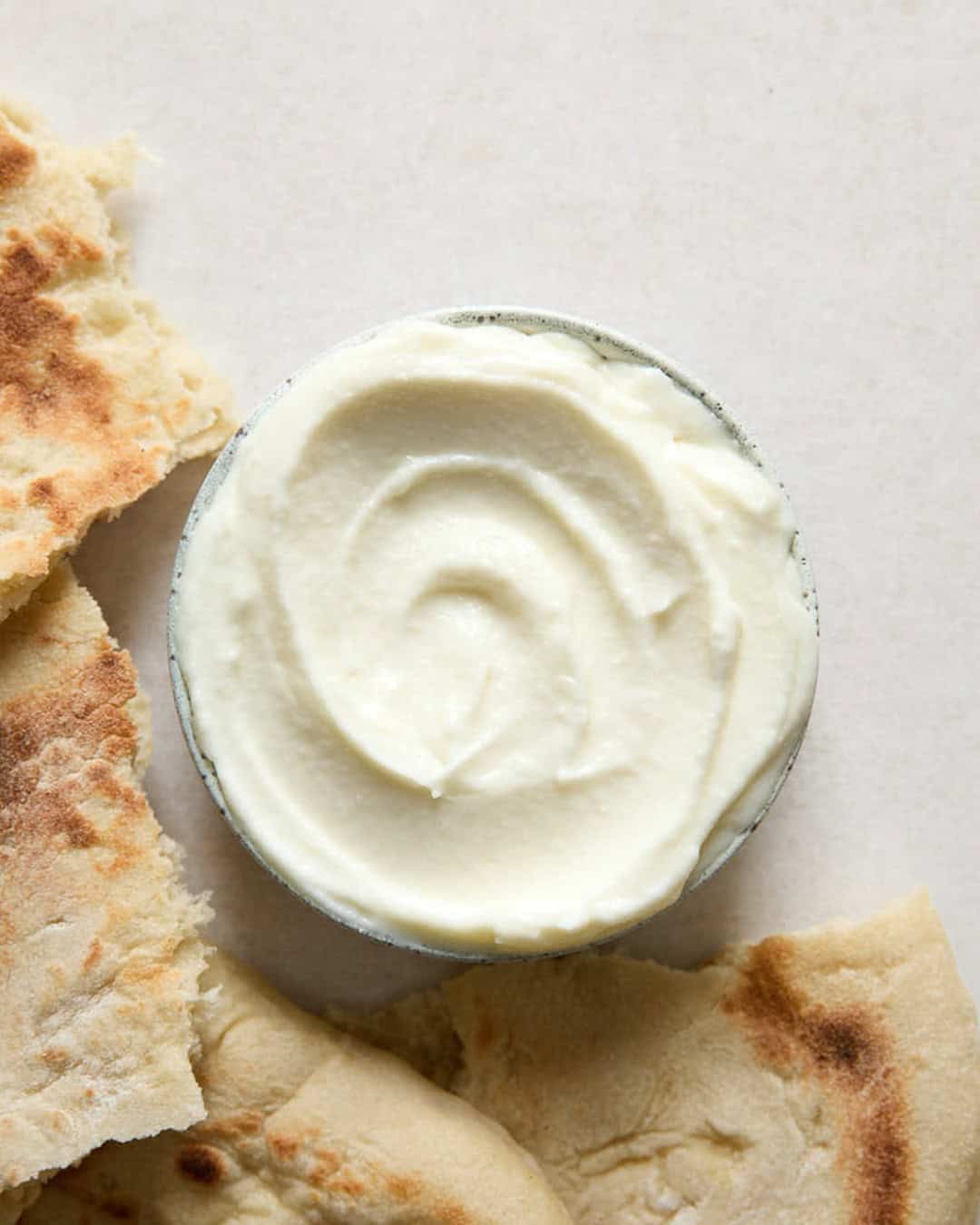
Excellent! Thank you!!! This recipe is perfect.
Wonderful! I’m glad you like it. 🙂
Hi,
Love your recipe and video. But, I’m doing something wrong. I’m using an imersion blender, 200ml canola oil, 70-72g of garlic, 1tsp salt. The first time I made it, it way WAY too salty. The 1nd time, I tried less salt, but I’d forgotten to take-out the germ, so it was bitter AND salty. This third time, I did remove the germ. This time, it broke, and the chick-pea hack didn’t work, so I added about a tsp of egg white, and it all came together.
My main question, is the salt… I’ve tried table salt, sea salt, and kosher salt. Is toum SUPPOSED to be salty? The saltiness is actually masking the taste of the garlic.
Please help
Hi Anthony, this recipe asks for 1/2 tsp salt, not 1 tsp. Have you tried that yet? But even with 1 tsp, it shouldn’t be too salty. Toum should certainly not taste salty, but it should quite tangy from the lemon juice. But just use less salt next time until you’ve found the sweet spot for you! Just for reference, I usually calculate 7g per tsp / 3-4g per 1/2 tsp. Maybe weigh it out if you have a scale that allows it.
And shame that the chickpea trick didn’t work. The liquid (aquafaba) has similar qualities to an egg white, so your solution was perfect!
I made some toum after stumbling across your YouTube video, and i LOVE this recipe! It’s absolutely delicious. Do you happen to know to nutritional info of this recipe? Ie, Kcal and fat etc. Would be great to know this, so that i can incorporate as part of my daily meals.
Unfortunately, I don’t calculate these yet on here. Will hopefully integrate it soon! I’m glad you liked it!
This is the best recipe so far. I especially like the immersion blender method. I do have a question though. Are you sure it will be good for 4 weeks stored in the refrigerator? I have a small container leftover from two weeks ago and I’m hesitant to use them although they look fine. What is it that keeps the raw garlic and lemon juice from molding as other processed raw vegetables would after a few days in the fridge?
Lemon and salt are natural preservatives. It’s fine, It can last even up to three months in the fridge. If it looks and smells fine, it’s safe.
Thanks for answering this!
Thanks for trying the recipe, I’m glad you like it! The salt, lemon juice and oil all help preserve the garlic, which makes toum so fridge-stable. 🙂 So yes, as long as it looks and smells (and then tastes fine), you can easily keep it for that time and still enjoy it!
Absolutely did not emulsify for me. I measured everything exactly but it was just white soup. Not mayo consistency.
I’m sorry to hear that! More than the precise measurements, it’s the technique that’ll emulsify it. It might be that too much oil was sucked in at once. The key is to start blending without lifting the blender at all to minimise the amount of oil in the beginning. Have you tried fixing the batch with some aquafaba?
Wow, I got it on first try thanks to your tips, the most important thing was to hold it still for 10-20 seconds without lifting or moving around. Do you have any tips on how to reduce taste of garlic a bit. It tastes a bit harsh or bitter. Thank you!
Amazing, I’m glad it worked! Keep the toum in the fridge for 1-2 days and the garlic should mellow out a bit. Next time, you can also try it with a little less garlic.
I just made this for the first time. OMG! I am a garlic lover and this is perfect. I’m rummaging through my fridge to see how many things I can put it on.
That was my reaction as well when I first tasted Toum! It’s so good, right?!
Absolute perfection! I followed the recipe exactly and was rewarded with a smooth, garlicky, lemony toum. (The recipe requires some patience. Be sure to keep the end of the immersion blender stable against the bottom of the mixing vessel until the contents start to emulsify and the sound of the blender deepens and muffles. Then move the blender in slight motions.) Many thanks for an excellent recipe!
Awesome! That’s wonderful to hear!
Before this recipe it took me 5 tries to make Toum. The immersion blender hack worked great on the first try! Thank you very much!
Awesome! It’s so much quicker!
Why is extra-virgin olive oil not recommended?
It becomes quite bitter when blended mechanically. Also didn’t want to believe it, but I learned the hard way… Allioli is traditionally made with extra-virgin olive oil (and also without egg), but there a pestle & mortar is used to first grind the garlic into a paste and then emulsify it with the oil.
I made this yesterday and had it today with some bbq chicken roasted garlic potatoes salad; it was delicious and enjoyed by all. We couldn’t beleive how smooth and creamy the texture was and just how good it tasted. I am a fan; I will be making this over and over again.
It’s also one of my favourite dips! Glad you liked it!
It was my first time making toum, and of course it didn’t work without the aquafaba (I think I lifted the immersion blender too fast or too much).
But once I added 2 tbsp aquafaba it turned out wonderfully and it tastes amazing. Thank you for this easy recipe!
Great! I’m glad it worked with the fix, phew! Yes, next time try to not lift the blender until you’re sure the toum has thickened at the bottom!
As a garlic lover, I’ll certainly try making this! The advice seems clear, and the photos are nice.
But more importantly, I noticed two typos on this article.
Under *How to Make Toum (Step-by-Step)*:
“Prepare your ingredients by gathering garlic, salt, oil, lemon juice and cold water .Peel”
The space is on the wrong side of the period before “Peel”.
Under *Ingredients You’ll Need and Substitutions*:
“Using extra virgin oils will give the tour a bitter flavor, so try to opt for natural oils.”
It should be “toum” rather than “tour”.
I just wanted to say this, because I know how much people appreciate it when random strangers correct their grammar. Have a merry Christmas!
Haha, thank you! I really do appreciate it, actually. That’ updated now 🙂
Seriously though, I made this yesterday, and it is awesome. A thick, creamy consistency and a robust, yet surprisingly mellow garlic flavour. Nice tang from the lemon, and the amount of salt is just right. Mine started emulsifying into a thick mayo right away, even without lifting the blender, but luckily this didn’t cause any problems (probably something to do with the shape of the blender and the vessel).
Sounds like an absolute success! That’s wonderful!
Mmmm yummy Toum is the best in lebanon.
I am lebanese and would like to share a new recipe with you.
To this dip we add additionally something called soumaq( it is a plant that we grind it down into powder like and it has a sour taste) and paprika powder. We eat this dip especially with grilled chicken.
Another recipe is adding garlic to labne (I think it is the speise quark) in germany). This is on of the mezza in lebanese resturant and called labne mtawme.
Thanks for sharing that!
Incredible! I was so excited to eat it I had a few spoonfuls. No vampires here! Thank you for sharing.
Haha the ultimate vampire repellent! Glad you liked it.
Amazing iff the first try. My weight loss goal is gonna be halted! No way you can’t eat it all right away!
Haha I’m with you!